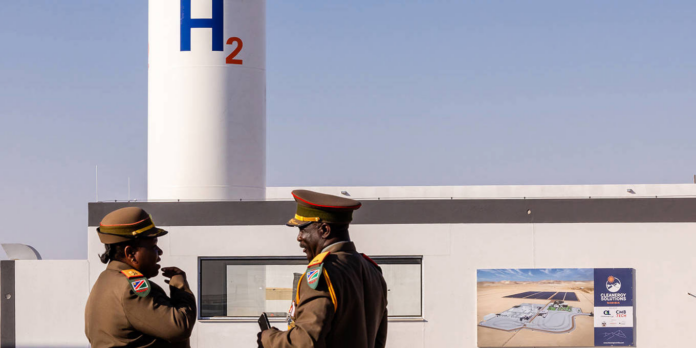SÃO PAULO – With the United Nations Climate Conference (COP30) in Belém, Brazil, approaching, it is clear that the world’s widely shared commitment to a just energy transition is falling by the wayside. In the year since governments signed on to the agreement at COP29 to scale up climate finance – with a goal of mobilizing $1.3 trillion annually by 2035 – wealthy countries have been retreating from their financial pledges. Worse, these signs of bad faith are coming just as the costs of climate adaptation and decarbonization in developing countries are mounting.
If the Global North is no longer willing to meet its funding promises, as now seems certain, it can still demonstrate good faith, nonetheless, through another form of solidarity: sharing the knowledge, technology, and intellectual property that underpin the green transition.
This is not an issue that can be deferred. The shift to a green economy is already reproducing the same asymmetries that have long defined global trade. Instead of fostering inclusive development, climate policy is increasingly being shaped by protectionist measures and IP regimes that entrench technological monopolies in the Global North. For example, the European Union’s Carbon Border Adjustment Mechanism may be billed as a safeguard against carbon leakage; but it also illustrates how climate policy can be used to justify protectionist trade measures.
Moreover, China’s recent complaint against India for its electric-vehicle and battery subsidies shows how green industrial policies are increasingly becoming grounds for trade disputes. Together, these developments signal a growing tension between climate goals and World Trade Organization rules. Could measures to address climate change soon become a new impetus for economic exclusion?
At the heart of this issue lies a stark imbalance: larger powers like China, the United States, and the EU are producing high-value green technologies, while most developing countries are stuck exporting low-value green commodities – primarily critical minerals. This mirrors the colonial-era division of labor, whereby the Global South supplied raw materials, and the North supplied innovation, monopolized production, and reaped the largest profits.
Data from the World Intellectual Property Organization underscore the depth of this divide. Green patents (relating to renewable energy, energy efficiency, and climate adaptation) are overwhelmingly concentrated in a handful of countries, such as China, the US, Japan, and Germany. Between 2000 and 2024, the top ten economies accounted for nearly 90% of international patent filings in solar and wind technologies. Brazil, despite ranking sixth globally in installed wind capacity, contributed only 0.4% of global wind patents. For solar, its share was a mere 0.19%.
This technological concentration is not accidental. It is the result of a global IP regime that privileges monopoly profits over public goods. Efforts to foster more global coordination, including through the Trade-Related Aspects of Intellectual Property Rights (TRIPS) agreement, have failed to address the fundamental problem.
Without access to affordable technologies, the Global South cannot fully participate in the climate transition. Worse, the current system risks locking developing countries into a new form of dependency, supplying the minerals for batteries and solar panels but lacking the means to produce them.
Climate finance is not sufficient to break this cycle. Instead, technology transfers and reforms to the global IP regime must be at the center of climate negotiations. While the UN Framework Convention on Climate Change and the Paris climate agreement do acknowledge this, little progress has been made.
Fortunately, there is a precedent for the necessary changes. Back in the 2000s, Brazil played a pivotal role in categorizing access to HIV/AIDS medicines as a public good, rather than as a commodity governed solely by IP rights. This shift was driven by a combination of legal, political, and civil-society actions that challenged the global pharmaceutical patent regime and put public health first.
As the Nobel laureate economist Joseph Stiglitz has argued, such mechanisms are essential to correct market failures and ensure equitable access to innovation. That is why the International Court of Justice, in its recent advisory opinion on climate change, underscored the obligation of all states to cooperate – beyond the provision of finance – on the development and diffusion of green technologies, including by sharing knowledge and engaging in technology transfers.
The Technology Implementation Program that was agreed at COP28 offers a means to foster such cooperation. Under Brazil’s leadership at COP30, TIP can become a platform for strengthening national innovation systems, enabling countries to adapt technologies to local contexts and build capacity for climate solutions. The idea is to use a mix of public and private money to support trial projects, and then to scale those that prove effective.
For example, we could support a pilot that aims to produce low-carbon fertilizer using green hydrogen. Currently, ammonia – the key input for nitrogen fertilizers – is made using hydrogen from fossil fuels, which is why the sector is responsible for roughly 1-2% of global carbon dioxide emissions. By replacing fossil-based hydrogen with renewable (green) hydrogen, the same ammonia output would produce far fewer emissions, as well as offering a scalable, locally adaptable solution. If the pilot succeeds in this hard-to-abate sector, it will create a replicable model for other countries.
Brazil’s COP30 presidency can rally the Global South behind a vision of TIP that delivers climate justice through innovation. This is not just a technical agenda, but a political one. Only by empowering countries with access to green technologies can they build the capacity they need. And by helping the rest of the world decarbonize, wealthy countries will be helping themselves.



